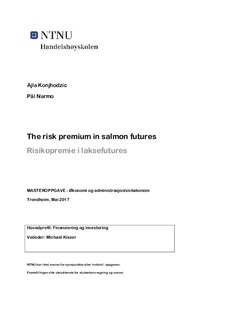The risk premium in salmon futures
Master thesis

Permanent lenke
http://hdl.handle.net/11250/2489450Utgivelsesdato
2017Metadata
Vis full innførselSamlinger
- NTNU Handelshøyskolen [1623]
Sammendrag
Futures contracts on fresh Atlantic salmon became available through Fish Pool in 2006. The volumes of traded futures have increased over the years, making Fish Pool a success as the only salmon futures provider in the world. This paper examines the relationship between spot and futures prices at Fish Pool in the period June 2006 through June 2016. Futures contracts with 1-, 2-, 3- and 6-months to delivery are used to identify the historical risk premiums in the salmon market. We analyze if the futures-spot basis significantly explains the variation in the risk premium. Our model incorporates monthly dummy variables, as well as biophysical and economic factors. The regressions are estimated in stages by adding variables to show how the coefficients of the futures-spot basis change. Results show that variation in the risk premium is mostly explained by the basis and seasonality. The risk premium is linked to unexpected shocks in biophysical and economic variables, but with low explanatory power. Shocks in production are significant for all four contracts. We find that the basis significantly explains the variation in the risk premium for contracts with 1-month to delivery. The results for the 2- and 3-month contracts show that the basis significantly explains the variation in the risk premium, especially when controlling for seasonality. For the 6-month contracts, however, we find that the basis in the risk premium regression becomes insignificant. The results indicate that basis primarily contains information about the future spot price changes. This study is of relevance to market participants in the salmon industry, as it provides valuable information on salmon futures as a hedging tool.